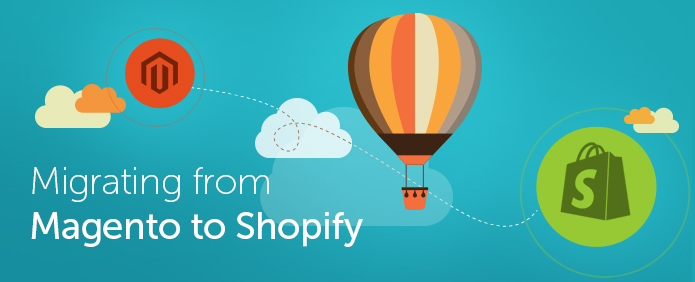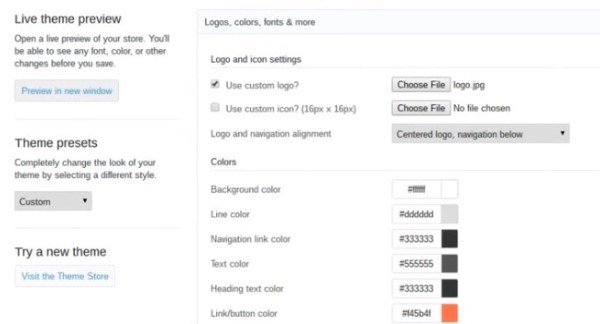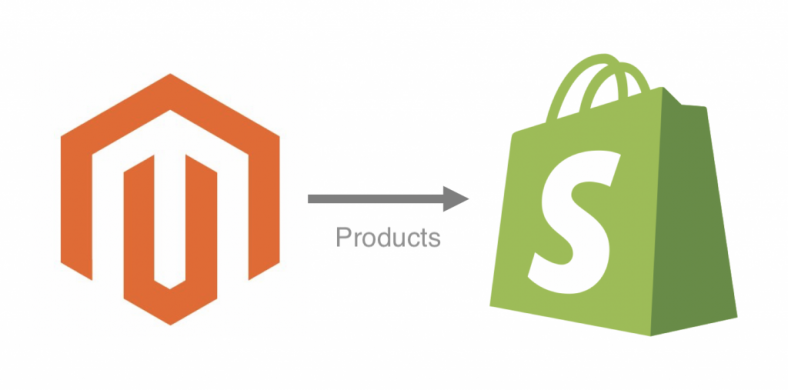29 Dec

Migrating from Magento to Shopify can be the greatest choice. E-Commerce can be built on many platforms but Shopify is the best of all. These days many merchants are migrating their business to Shopify.
Therefore, for a lot of store owners migrating from Magento to Shopify would be a fresh start. When it comes to decide which platform to choose for your web store, Shopify is on top amongst all.
In addition Shopify benefits your store in growing fast. It’s ease of use, friendly interface, and marketplace of amazing themes and apps have made it a great fit for many businesses worldwide.
Moreover, once you have decided to migrate from Magento to Shopify, there will be several steps to follow. You can do it yourself or you can seek help of some agency who is migration experts which will make migration smooth and easier.
This will give you the step-by-step guidance for migrating from Magento to Shopify efficiently.
STEP 1: Decide what you need before starting:
This is the main step to start migration. Firstly decide what you actually want and how you want your store to look like. Here are some questions which you need to keep in mind so you don’t have to make last minute changes.
Why are you migrating ?
- What is you actual problem?
- Do you want the whole site control?
- Expensive developer times?
- You need to do things on your own for your website?
- Long update cycles?
Please make sure whatever you need is there from the beginning of new store.
Do you have all the data from current website ?
Your web store is what represents your brand. Therefore, when you to update or change your website design, you will need help of experts to make what you desire for. Now this is the time you need to collect data from your site before migrating from Magento to Shopify.
Furthermore, data could be of two type:
1. Quantitative Data:
This is about how many people land on specific pages? OR Where do they do afterwards? OR What site content is driving the traffic and helping in purchase?
Hence, Google analytics will be supportive in letting you know all this.
Moreover, here is the quantitative data you should collect:
- Which pages draw in the most traffic and lead to conversions?
- Which pages have people leaving without buying and have highest bounce rates?
- Who are your best customers by demographic groups?
- What stages of your checkout funnel do people drop out of most often?
- How far down the page do people scroll and view?
- Where are people clicking most often? Is it outside of what you would expect?
2. Qualitative Data:
Similarly qualitative data is about people and what action do they take. Heatmaps provide great qualitative feedback on how users interact with a page.
Therefore, here is the qualitative data you should collect:
- How do your customers describe themselves?
- How do they describe you to other people?
- What role do your products have in their daily life?
What are your plans for investment ?
Hence, migrating from Magento to Shopify would not be cheap. Moving towards Shopify will be worth each penny and will take your store to the next level.
Still you need to understand what you need and what investment are you ready to make. This will let you set your expectations according to your budget.
Similarly, store with large number of products, demanding development and designs can have high range prices. But when you want a business that grows over time, you will realize the investment will pay for itself many times.
While Magento has costs that stack, Shopify stores pay a single monthly fee for access to full functionality. So instead of paying monthly or annually for:
- Hosting
- Maintenance
- Upgrade dev time
- Maintenance dev time
- Bandwidth
- Security fixes
Also, moving to Shopify may be a scary vision but Shopify saves your time, money and you don’t need to worry about any technical things.

IMPORTANT POINTS
- Jot down your reasons of migration.
- Find out what data do you have.
- Look at your finance.
STEP 2: Business should be kept running:
Migrating from Magento to Shopify can take time. Therefore, don’t shutdown your Magento store while building up store on Shopify. Your Magento store should be running until the new store is not ready to use.
STEP 3: Design you homepage:
Website design is the center of attraction of your web store. As discussed above you website design reflects your brand. So, you need to take some serious steps when you move platform:
- Replicate your current site design
- Use the current design as a starting point
- Completely redesign your site from scratch
Which one do you need depends upon how you actually want your website to look like.
1. Replicate your current website design :
Copying your current Magento website on Shopify can be the most expensive way to move on. But if you are willing to have a carbon copy of your website then this is the best choice for you to go with.
Furthermore, here are some pros and Cons of choosing this.
Pros :
- Existing media and content resources can be reused
- Current performance stats for the site are known
- The launch time is faster
- Cost estimates are more accurate
Cons :
- The older layouts can be difficult to adjust for mobile responsiveness
- Can be labor intensive to move the site to the new platform
- May not be optimized for profit-generating design
2. Use current design as a starting point :
Magento and Shopify are two different platforms with different functionalities and designs. With the new platform you can refresh your website’s look.
In addition to this, you can update your website by maintaining the image of your brand to which customers are already familiar with.
Pros:
- Maintain the brand look to make customers feel familiar
- Refresh your site with a focus on growing conversions and revenue
- More flexible options for theme and budget
- Reuse many of your visual and content assets
Cons:
- If your imagery and messaging isn’t focused tightly on your ideal buyer, bringing it with you won’t help
- Redesigns always carry some risk of the unknown
3. Design your website from scratch :
Similarly, you can design your website from scratch too. When migrating it’s the best opportunity to bring your website design up to speed.
Hence, you need to collect data from your current website to know what is working for you and what’s not working for you.
Pros:
- Redesigning offers chance to look at many issues at once when moving platforms. Anything that bugs you about your websites design can be fixed easily.
- It’s easier for customers to navigate and use your site to buy.
- Redesigning lets you focus your appeal on your customers.
Cons:
- If your imagery and messaging isn’t focused tightly on your ideal buyer, bringing it with you won’t help
- Redesigns always carry some risk of the unknown
STEP 4: Choosing your Theme:
The main part of the designing will be choosing a theme for your website. In Shopify your theme determines the framework of your website’s appearance, back-end editing options and some customer facing functionalities.
Moreover,
Majority of the e-commerce functionalities are already the part of Shopify’s platform. You can find a lot of themes in Shopify theme store and by adding apps or some codes to your themes you will be able to have advanced functions.

Furthermore, some advanced theme functionalities are:
- Personalized products (monogramming)
- Quick-add-to-cart from product display grids
- Drop-down navigation mega menus
- Filtering options on category pages
- Social sharing of products
In addition there are three levels of themes:
- Free or Low cost themes
- Premium themes
- Custom themes build
1. Free Themes :
They are best choice when :
- Need to move your website to Shopify platform NOW
- You have small budgets
- You have small product catalogs
Pros of Free Themes :
- Fastest deployment time
- Lowest cost
- Checked and reviewed by others
Cons of Free Themes :
- Least built-in functionality
- Some may not be suitable for stores with complex product catalogs
- Many don’t offer the flexibility you want coming from a platform like Magneto
2. Premium Themes :
They are best choice for mid to large sized stores that may eventually need a fully custom theme, but aren’t there yet, and use a tailored premium theme.
Pros of Premium Themes :
- More functionality and flexibility than free themes.
- Not as expensive as a full custom build.
- Features can be added and can make more extensive design changes.
Cons of Premium Themes :
- Can still be expensive if you need extensive customization done.
- Altering code of customized theme can add bloat and complexity to code if not done by experienced developers.
- Can cause issues with compatibility and upgrades.
3. Custom Build Themes :
They are best choice for :
- Brands that want to create a completely original store experience.
- Brands with the budget to create what they need.
- Stores in need of advanced functionality and don’t want to plug in lots of apps.
Pros of Custom Build Themes :
- Offers the flexibility and functionality.
- Best way to separate yourself from the competition.
- Some custom functionality can be built in, lowering page load times.
- Built-in functionality can reduce the need to pay monthly for apps.
Cons of Custom Build Themes :
- Most expensive.
- Tied to the creator for the best lifetime service – not a problem if you choose a solid agency to work with.
- Longest launch cycle.
Hence, which theme you should go with depends upon you budget and what do you actually want.
IMPORTANT POINTS
- Make up your mind on what design you want.
- Choose your theme
- Set your budget for designing
STEP 5: Apps and Integrations you required :
The final tier of launching a functional store are Shopify apps and tech partners. The Shopify App Store will have large range of add-on functionality.
Moreover, if you need to integrate deeply with business-critical systems (inventory management, certain CRMs, warehousing, etc.) developers can create custom solutions for almost anything you would ever need to connect to your store.

Similarly, you can easily find easy to use connector to plug third party service like marketing tools, inventory management and more. Plus you can find that your theme doesn’t include already.
Now, you need to think what tools and features you need to run your store, and how that will happen.
- Is it a base-level Shopify feature?
- Does it require an app? What apps are best and how much will you have to invest in them each month?
- What third-party tech do you have? Think of social and email marketing, ad platforms, etc.
- Do you have any super deep, uncommon connections such as suppliers, fulfillment, shipping, etc.? What kind of connection do they require?
STEP 6: Migrate :
Migrating from Magento to Shopify would look easier but actually it’s not. You have to move :
- Products
- Content
- Data of customers
You can even use spreadsheets (CSV files) to do much of the work. To be honest about it, getting your data exported from Magento and format it correctly in Shopify can be a horror.
Therefore, I would again advise you to not do it on your own. This is not a self-serving advice but you can corrupt your data by trying it by yourself.

1. Products :
Products can be exported from Magento as CVS file because Shopify can import data from CVS file easily. Hence, the architecture for handling products and variants doesn’t transfer from one to the other, so the data export from Magento must be extensively reformatted before Shopify can read it.
In Addition, there are apps that can handle this for very small product catalogs like:
But the issue with these software solutions is you can still end up with errors in your CSV files that need human involvement to fix.
2. Content :
When we talk about content. There are types of content discussed below:
There is static, mostly unchanging content:
- Terms and Conditions
- Privacy Policy
- Support Pages
- Return Policy
- About Page
Then there is dynamic content, which is more subject to change:
- Product pages
- Category pages
- Blog posts
- Homepage
- News and events
Finally, there are files you have uploaded to the site:
- Images
- Lead magnets
- Downloadable sizing guides or instructions
Most stores have the best option is to move on-page copy and images manually, adding them to your new Shopify store. One exception might be a blog on WordPress. Excelify the blog import tool will be helpful in this case to transfer a WordPress blog to Shopify blog.
Your best option is to look at this as an opportunity to simplify:
- What content is necessary?
- How big is your blog and how much of it actually does you any good at all?
- Are there products on your site that just never sell?
By using Google Analytics, you can see what content is actually drawing attention, and make decisions of removing content this will decrease the time and cost of moving, and improve the performance of website too.
Therefore,If you have 50,000 monthly visitors and some of your posts or landing pages are bringing in 50 visitors per month. Unless you have prove that majority of those 50 visitors make a purchase each month, you should remove those pages.
3. Data of Customers :
This is the most important yet sensitive data. Like products CVS import is the option, and Shopify API also.
Customer data have many things like, Customer data, Order history, Discount codes and Gift cards. Choosing the right import method is very necessary.
Choosing the right way for this should be the decision of Shopify experts who help you move your data.
STEP 7: Find someone to help you for migrating data :
This is a very necessary part of migration. Trying to migrate on your own could be disaster. Because migrating data is technical and difficult to do when you have large number of products and customer data. Consequently there is much possibility that you corrupt your data.
Therefore, seek help of expert maybe some agency like ours (Xperteria) to tackle these tasks one by one.
IMPORTANT POINTS
- Decide what content is worth moving
- Find a Shopify Expert
STEP 8: Do test :
Additionally, do test to check if everything is running correctly. Make sure that customer’s data is organized and displaying properly. Run some test orders. Check if you’re able to manage every aspect of your business. Double check everything on your website, as first impressions really count.
STEP 9: Launch and Optimize :
Finally, you have built your new store. You have moved all your stuff in your new store. Now you think you are done, but no you are never done. Things change time to time and you need to change your store according to it.
Once your store is up and running, there are two key areas to keep optimizing on the site.
- SEO
- CRO
1. SEO (Search Engine Optimization)
Organic traffic from search is not free, but low cost and profitable enough.
Shopify is built to make best of technical SEO which mean not much improvements need to be done there. The area where you can make difference are:
- Make sure you have set up your pages, posts, products, and images with keyword-focused metadata.
- Submit your XML sitemap to Google Search Console.
- Configure 301 redirects so traffic going to your old URLs will land on the correct pages on your new site, as it will have a different URL structure.
- Create keyword-rich content on pages and posts that draws in searchers looking for the things you sell.
A note on Shopify, URLs, and SEO: Shopify has an unchangeable URL structure that denotes pages and posts.
- /collections for collection pages
- /products for product pages
- /blogs/blog-name for different blogs and posts
So when you move, your URLs would go from “www.site.com/9-dog-treats” to “www.site.com/blogs/blog-name/9-dog-treats”.
In past people had an opinion that URL would affect search engine rankings. Maybe this could be ten year ago but not now. The change in URL will not cause your ranking.
Migrating from Magento to Shopify can negatively affect search engine rankings if not done well, but sometimes they actually boost SERP position by clipping bad links and dead pages, improving user experience, and building more functional websites with better technical SEO practices.
1. CRO (Conversion Rate Optimization)
This is the key of growth for store. Using data to make your site better at selling is a must for anyone who wants to increase their sales. At a minimum, you should be using:
- Shopify built-in analytics reporting
- GoogleAnalytics
- HotJar (heat maps and user polls)
- Customer Surveys
By using these tools you will be able to draw a wealthy data from your website. Moreover, it will help you see if there are any issues with particular website page, or with specific devices and web browsers after the moves.
IMPORTANT POINTS
- Make sure to have best practice for SEO
- Create a plan to add more content to your website
- Install measurement tools to improve marketing
Wrap up :
This is a lot to read but migrating from Magento to Shopify isn’t an easy task to do. Do read all the step properly, make sure you have everything clear in your mind first then start working. If you are much into web designing then please do take help of some agency or someone who is Shopify Expert.
Furthermore, make a checklist of everything and do properly plan to migrate. No doubt migrating From Magento to Shopify is the greatest decision. But Shopify is the best E-Commerce platform which comes up with many built in tools required for an E-Commerce website. It is easy to use and user friendly platform.

Plus 24/7 customer support via phone, e-mail and live chat is also available. Shopify being the top E-Commerce platform hosts your website for you and you don’t have to worry about any technical issue while using Shopify.
Moreover, Shopify come with plenty of themes both free and paid. Thousands of apps are also available at Shopify app store to make your store more advanced and updated.
Migrating your store can be daunting at times, but to make your life easier, you can seek help of Certified Shopify Migration Experts.
